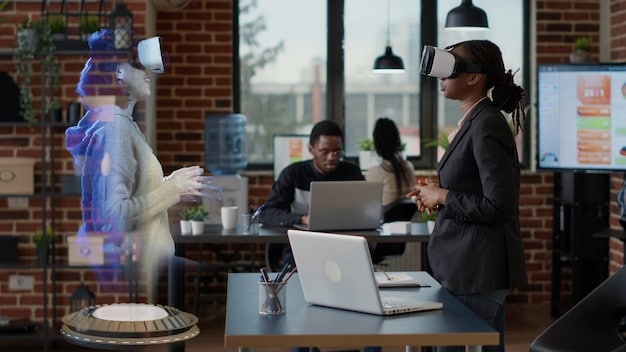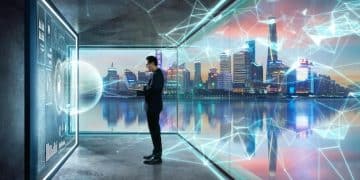Future-Proof Your Job: Essential Skills Against Automation in 5 Years

The rapid advance of automation necessitates a proactive approach to career development, focusing on cultivating uniquely human skills like critical thinking, creativity, and emotional intelligence to ensure job security in the evolving workforce.
In a world increasingly shaped by technological advancements, a fundamental question emerges for professionals across every sector: Is Your Job Safe? Discover the Skills That Will Protect You From Automation in the Next 5 Years. Understanding the trajectory of automation and identifying the indispensable human capabilities that machines cannot replicate is crucial for career longevity and success.
Navigating the Automation Landscape: Current Trends and Future Outlook
The conversation around automation often conjures images of robotic assembly lines and driverless cars, yet its influence extends far beyond manufacturing and logistics. Modern automation, powered by artificial intelligence (AI) and machine learning (ML), is permeating white-collar professions, impacting data entry, customer service, and even complex analytical tasks. This shift isn’t merely about job displacement but rather job transformation.
Current trends indicate that repetitive, rule-based tasks are most susceptible to automation. This includes administrative support, basic accounting, and even certain aspects of legal research. However, the future outlook suggests a more nuanced interaction between humans and machines. Instead of outright replacement, many roles will evolve to become “augmented,” where AI tools enhance human capabilities, handling routine tasks and providing insights while humans focus on higher-level problem-solving and strategic decision-making.
The pace of this transformation is accelerating, driven by advancements in computational power, data availability, and the decreasing cost of AI technologies. Industries from healthcare to finance are already leveraging automation to improve efficiency and accuracy. This doesn’t mean mass unemployment is inevitable, but it strongly signals the need for continuous skill development and adaptability.
Understanding these trends is the first step toward self-preservation in the job market. It’s about recognizing that the nature of work is changing, and our professional identities must evolve alongside it. The emphasis shifts from “what you know” to “how you learn and adapt.”
Beyond the Algorithm: Skills Automation Can’t Replicate
While algorithms excel at processing vast amounts of data and performing calculations with superhuman speed, there’s a distinct set of human attributes that remain largely beyond their grasp. These are the skills that will form the cornerstone of future-proof careers. Understanding these uniquely human capabilities is paramount for anyone looking to secure their professional future amidst the rise of automation.
Critical Thinking and Complex Problem-Solving
Machines can analyze data for patterns, but they struggle with abstract reasoning, ethical dilemmas, and problems that lack clear precedents. This is where critical thinking, the ability to analyze information objectively and form a reasoned judgment, becomes indispensable. Complex problem-solving involves not just identifying issues but also creatively devising novel solutions, often requiring empathy and an understanding of human motivations.
- Analyzing nuanced situations that lack clear-cut data.
- Developing innovative strategies for unforeseen challenges.
- Evaluating ethical implications beyond simple data points.
Creativity and Innovation
True creativity, the capacity to generate new ideas, concepts, or artistic forms, is inherently human. While AI can create art or music based on existing patterns, it lacks genuine originality or the ability to challenge conventional thinking. Innovation, the application of new ideas to create value, relies heavily on this human spark. Roles in design, research, marketing, and entrepreneurship will continue to demand this skill.
Consider the role of a product designer: an AI might optimize design elements based on user data, but it cannot conceptualize a revolutionary new product that addresses an unarticulated need. That leap of imagination is profoundly human.
Emotional Intelligence and Interpersonal Skills
Navigating human relationships, understanding unspoken cues, and managing emotions are complex tasks that elude AI. Emotional intelligence encompasses self-awareness, empathy, motivation, and social skills. Careers requiring high levels of human interaction—such as sales, human resources, teaching, healthcare, and leadership—will place an increasing premium on these abilities.
The ability to motivate a team, resolve conflicts, or provide compassionate care requires a nuanced understanding of human emotions that algorithms simply cannot replicate. These “soft skills” are becoming the new “hard skills” in an automated world.
In essence, the skills that automation cannot replicate are those that tap into the core of human cognition and connection. They are the abilities that allow us to interact empathetically, think abstractly, and innovate freely, ensuring our value in a technologically advanced future.
Future-Proofing Your Career: Proactive Strategies for Skill Development
To remain competitive and relevant in an automated future, individuals must adopt a proactive approach to their career development. This goes beyond simply acquiring new technical skills; it involves cultivating a mindset of continuous learning, adaptability, and strategic self-improvement. The goal is not just to survive but to thrive, leveraging the unique human attributes that automation cannot replicate.

Embracing Continuous Learning and Lifelong Education
The days of learning a trade and sticking with it for a lifetime are largely over. The rapid pace of technological change demands a commitment to continuous learning. This means actively seeking out new knowledge, whether through formal education, online courses, workshops, or even self-study. Platforms offering MOOCs (Massive Open Online Courses) provide accessible avenues for acquiring new skills, from data analytics to design thinking. Investing time and resources in learning is no longer an optional luxury but a professional necessity.
Consider dedicating a specific amount of time each week to learning, treating it with the same seriousness as your other professional duties. This could involve reading industry publications, attending webinars, or experimenting with new software.
Developing Hybrid Skill Sets: The Human-Tech Synergy
The most resilient professionals will be those who can bridge the gap between human capabilities and technological tools. This involves developing “hybrid” skill sets that combine traditional human skills with a working knowledge of relevant technologies. For instance, a marketing professional who understands data analytics and AI-powered advertising platforms will be far more valuable than one who only comprehends traditional marketing strategies.
Similarly, a healthcare worker with empathy and strong communication skills who is also proficient in using telehealth systems and electronic health records will be highly sought after. The synergy between human judgment and technological efficiency creates a powerful new archetype of the professional.
- Combining creativity with digital design tools.
- Pairing critical thinking with data analysis software.
- Merging emotional intelligence with customer relationship management (CRM) systems.
Cultivating Adaptability and Resilience
The future of work will be characterized by unpredictability. Jobs may change, industries may shift, and new technologies will continually emerge. Cultivating adaptability—the ability to adjust to new conditions—and resilience—the capacity to recover quickly from difficulties—are crucial psychological attributes. This involves embracing change as an opportunity rather than a threat, and viewing setbacks as learning experiences.
Developing a growth mindset, where challenges are seen as opportunities for development, will be key to navigating a dynamic career landscape. This psychological flexibility is as important as any technical skill in the face of ongoing automation.
By proactively engaging in continuous learning, embracing hybrid skill sets, and fostering adaptability, individuals can truly future-proof their careers and ensure their professional relevance in an increasingly automated world.
The Rise of Cognitive Empathy and Collaboration
As automation handles more routine and analytical tasks, the demand for skills that facilitate uniquely human interaction will intensify. Two such critical competencies are cognitive empathy and sophisticated collaboration, which allow individuals to understand and work effectively with diverse perspectives and complex human dynamics.
Understanding Cognitive Empathy
Cognitive empathy involves the ability to understand another person’s perspective, thoughts, and intentions. Unlike emotional empathy (feeling what another person feels), cognitive empathy is about intellectual understanding. This skill is vital in fields like customer service, sales, design, and product development, where understanding user needs, client motivations, or team dynamics is paramount. Machines can process data on user behavior, but they struggle to truly grasp the underlying reasons or nuances of human thought.
For example, a customer service representative needs to not just solve a problem but also understand the customer’s frustration or urgency. A designer must anticipate how a user will interact with a product, not just based on metrics, but on an intuitive understanding of human behavior and cognitive processes.
This skill enables better communication, conflict resolution, and the creation of more user-centric solutions. It’s about putting yourself in someone else’s shoes, intellectually, to anticipate their needs and reactions.
Fostering Sophisticated Collaboration and Teamwork
While project management software can streamline tasks, true collaboration—especially on complex, creative, or interdisciplinary projects—requires subtle human interaction. This involves active listening, negotiation, influencing without authority, and the ability to build consensus among diverse stakeholders. Automation can facilitate collaboration by handling administrative aspects, but it cannot foster the trust, rapport, and creative friction essential for high-performing teams.
- Mediating disagreements and finding common ground.
- Leveraging diverse skills and perspectives within a team.
- Building trust and psychological safety among colleagues.
The ability to lead cross-functional teams, work effectively in agile environments, and bridge communication gaps between technical and non-technical stakeholders will be highly prized. As workplaces become more distributed and diverse, the capacity for sophisticated, human-centric collaboration will be a distinguishing factor for career success.
In essence, the rise of automation liberates humans to focus on the intricate and often messy aspects of human interaction and collective intelligence. Cognitive empathy and collaborative prowess are no longer just “nice-to-haves” but fundamental skills for navigating the future of work.
The Strategic Edge: Data Literacy and Digital Fluency
While uniquely human skills are critical, a strategic understanding of how automation operates and how to leverage digital tools provides a significant advantage. This involves developing strong data literacy and digital fluency, enabling professionals to interact effectively with automated systems and extract meaningful insights.
Understanding Data Literacy in an Automated World
Data literacy is the ability to read, work with, analyze, and argue with data. In an automated world, this skill is paramount. It’s not about becoming a data scientist, but about understanding how data is collected, interpreted, and used by AI and automation systems. This includes recognizing biases in data, understanding statistical significance, and being able to question the outputs of algorithms. Without data literacy, individuals risk becoming passive recipients of automated decisions, unable to contribute meaningfully or critically evaluate results.
For instance, a marketing manager needs to understand not just the recommendations generated by an AI marketing tool, but also the data points and assumptions that led to those recommendations. This critical understanding allows for better decision-making and strategic adjustments.
Cultivating Digital Fluency and AI Familiarity
Digital fluency moves beyond basic computer literacy; it involves the ability to intuitively understand and adapt to new digital technologies, including AI tools. This means being comfortable experimenting with new software, understanding the capabilities and limitations of AI applications, and knowing how to integrate these tools into existing workflows. It’s not about coding, but about being an informed user and strategic implementer of technology.
- Experimenting with AI-powered language models for content generation.
- Utilizing automation tools for routine administrative tasks.
- Understanding the basics of machine learning to better leverage predictive analytics.
The professional of the future won’t necessarily build AI, but they will certainly use it. Familiarity with AI concepts, even at a high level, will enable professionals to identify opportunities for automation within their roles, troubleshoot issues, and communicate effectively with technical teams. This strategic engagement with technology positions individuals as valuable assets, capable of optimizing their own work and contributing to organizational efficiency.
By pairing core human attributes with a strong foundation in data literacy and digital fluency, individuals can become “bilingual” in the language of both human insight and technological efficiency, achieving a formidable strategic edge in the evolving job market.
Adaptability vs. Obsolescence: The Mindset Shift Required
The conversation about job safety in an automated future isn’t solely about acquiring new skills; it’s fundamentally about a profound mindset shift. The traditional career path, often characterized by stability and predictable progression within a single domain, is rapidly becoming obsolete. In its place, a new paradigm emerges, one centered on relentless adaptability and a proactive embrace of change. The choice before every professional is stark: adapt or face obsolescence.
Embracing Disruption as an Opportunity
Many view technological disruption with trepidation, seeing it as a threat to job security. However, highly adaptable individuals learn to reframe disruption as a catalyst for new opportunities. This involves proactively seeking out new trends, understanding their implications, and identifying how one’s existing skills can be reapplied or augmented to meet emerging needs. It’s about being a “first mover” in adopting new tools or understanding new methodologies, rather than waiting until they become mainstream.
Consider the rise of remote work: those who quickly adapted to virtual collaboration tools and communication strategies found themselves well-positioned, while others struggled. This same principle applies to automation: see it as a chance to redefine your role, not eliminate it.
Cultivating a Growth Mindset
A “growth mindset,” a concept popularized by Carol Dweck, is crucial for navigating an uncertain future. This involves believing that one’s abilities and intelligence can be developed through dedication and hard work, rather than being fixed traits. In the context of automation, a growth mindset empowers individuals to view skill gaps not as limitations, but as areas for development and mastery. It fuels the desire for continuous learning and the courage to tackle new challenges.
Without a growth mindset, the fear of inadequacy can lead to paralysis, preventing individuals from acquiring the very skills needed to stay relevant. It’s about moving from “I can’t do that” to “I can’t do that yet, but I can learn.”
- Viewing challenges as opportunities for skill acquisition.
- Seeking constructive feedback to identify areas for improvement.
- Persisting through setbacks and viewing them as learning experiences.
The Importance of Psychological Resilience
The journey of continuous adaptation can be demanding, filled with uncertainty and the occasional setback. Psychological resilience—the ability to bounce back from adversity—is therefore essential. This involves maintaining a positive outlook, managing stress effectively, and building a supportive professional network. Resilience allows professionals to weather periods of
transition, remaining optimistic and proactive even when faced with significant change in their industry or role.
The future of work favors the flexible, the curious, and the courageous. By internalizing this mindset shift, professionals can not only future-proof their careers but also discover newfound professional satisfaction in a dynamic, evolving landscape.
Crafting Your Personalized Automation-Proof Career Path
Securing your job in an automated future isn’t a one-size-fits-all endeavor; it requires a personalized and strategic approach. By assessing your current strengths, identifying critical future skills, and actively seeking opportunities for growth, you can craft a unique career path that leverages your human advantages and adapts to technological shifts. This involves introspection, planning, and consistent action.
Assessing Current Skills and Identifying Gaps
Begin by taking stock of your existing skills, both hard and soft. Objectively evaluate which of these are susceptible to automation and which are uniquely human. Then, identify the critical future skills discussed previously—critical thinking, creativity, emotional intelligence, data literacy, digital fluency, adaptability—and honestly assess where your strengths and weaknesses lie. This self-assessment is the foundation for creating a targeted development plan.
This might involve speaking with mentors, reviewing industry reports, or even taking online skill assessments to gain an accurate picture of your current professional landscape.
Strategic Learning and Skill Acquisition
Once you’ve identified your skill gaps, create a strategic learning plan. This isn’t about aimlessly accumulating certificates but about acquiring skills that directly address your weaknesses and align with future job market demands. Prioritize skills that offer the highest return on investment in terms of career longevity and growth potential. This might mean enrolling in specific online courses, attending workshops, or even pursuing a micro-credential in areas like AI ethics or advanced data visualization.
Look for opportunities to apply newly acquired skills in your current role, even if it’s through small projects or volunteer work. Practical application solidifies learning.
Networking and Mentorship for Future Foresight
Building a robust professional network is more important than ever. Connect with individuals who are at the forefront of technological change, whether in your industry or related fields. These connections can provide invaluable insights into emerging trends, skill requirements, and potential opportunities. Seek out mentors who possess the future-proof skills you aspire to develop; their guidance can accelerate your learning and provide critical career navigation advice.
Active participation in professional communities, both online and offline, can expose you to cutting-edge discussions and innovative thinking that might not yet be widely publicized.
Crafting an automation-proof career path is an ongoing journey of self-discovery and strategic investment. By continuously assessing, learning, and connecting, you can ensure that your professional trajectory remains resilient and rewarding in an increasingly automated world.
Building a Culture of Human-Centric Innovation
Ultimately, safeguarding jobs from automation isn’t just an individual responsibility; it also involves fostering a broader organizational and societal culture that prioritizes human-centric innovation. This means redesigning roles that leverage unique human capabilities, investing in workforce upskilling, and rethinking how technology can augment, rather than simply replace, human effort. It’s a shift from purely efficiency-driven automation to a more thoughtful, partnership-based integration of humans and machines.
Redesigning Roles for Human-Machine Collaboration
Instead of viewing automation as a threat that eliminates jobs, progressive organizations are redesigning roles to create synergy between humans and machines. This involves identifying tasks that AI excels at (e.g., data processing, pattern recognition, repetitive actions) and reassigning them to automation, thereby freeing up human employees to focus on tasks that require creativity, critical thinking, emotional intelligence, and complex problem-solving. This creates “hybrid roles” that are more engaging and valuable.
For example, rather than an accountant being fully replaced, their role might evolve to focus more on strategic financial planning and advisory services, with AI handling routine bookkeeping.
Investing in Reskilling and Upskilling Initiatives
For this human-machine collaboration to flourish, organizations must make significant investments in reskilling and upskilling their existing workforce. This means providing accessible training programs that help employees acquire the “future-proof” skills needed to work alongside AI and automation. Such initiatives contribute to employee retention, morale, and overall organizational resilience in the face of technological change. This could include internal training programs, partnerships with educational institutions, or subsidies for external courses.
- Developing internal training academies for AI literacy.
- Offering tuition reimbursement for relevant higher education programs.
- Implementing mentorship programs to transfer expert knowledge.
Prioritizing Ethical AI and Human Oversight
As automation becomes more pervasive, ensuring ethical use and human oversight is paramount. Organizations need to develop clear guidelines and policies for AI implementation, focusing on transparency, fairness, and accountability. This includes maintaining human-in-the-loop systems for critical decisions, ensuring that algorithms are not biased, and providing avenues for human appeal when automated systems make errors. Prioritizing ethical AI builds trust and ensures that technology serves human well-being, rather than undermining it.
A commitment to human-centric innovation recognizes that the greatest value lies not in replacing humans with machines, but in empowering humans with intelligent tools to achieve greater impact. This collaborative vision offers the most sustainable path forward in an automated world.
| Key Skill | Brief Description |
|---|---|
| 💡 Critical Thinking | Analyze complex situations and generate novel solutions. |
| ❤️ Emotional Intelligence | Understand and manage emotions in human interactions. |
| 🔄 Adaptability | Adjust to new conditions and embrace continuous learning. |
| 🧠 Digital Fluency | Effectively use and understand evolving digital technologies. |

Frequently Asked Questions About Job Safety and Automation
While automation will undoubtedly displace some jobs, it’s more accurate to envision job transformation rather than complete elimination. Many roles will evolve into “augmented” positions where humans work collaboratively with AI and automated systems, leveraging technology to enhance their productivity and focus on higher-value tasks that require unique human skills like creativity and emotional intelligence. New jobs that currently don’t exist will also emerge.
Uniquely human skills are those capabilities that automation struggles to replicate. These include critical thinking, complex problem-solving, creativity and innovation, emotional intelligence, advanced interpersonal communication, and the ability to navigate ethical dilemmas. These skills require nuanced understanding, abstract reasoning, and human empathy, making them invaluable in an increasingly automated world. Their development is crucial for job security.
Continuous learning is absolutely critical. The rapid pace of technological advancement means that skills can become obsolete quickly. Professionals must commit to lifelong learning, constantly acquiring new knowledge and adapting their skill sets to meet evolving industry demands. This isn’t just about gaining new technical skills but also about cultivating a flexible mindset that embraces change and views learning as an ongoing, essential part of professional life.
Absolutely. Data literacy and digital fluency don’t necessarily require a deep tech background like coding. They focus on understanding how to interpret data, recognize patterns, and effectively use digital tools and AI applications to enhance your work. Many online courses and resources are designed for non-technical professionals, making these skills accessible to anyone willing to invest time in learning. It’s about strategic understanding, not just technical execution.
Adaptability is a cornerstone for job security in an automated future. It’s the ability to adjust to new conditions, embrace change, and remain flexible in the face of evolving job roles and industry shifts. A high degree of adaptability allows professionals to pivot their careers, acquire new skills, and navigate uncertainty with resilience. It fosters a proactive mindset where disruption is seen as an opportunity for growth, not a threat to stability.
Conclusion
The journey to understand whether your job is safe in an era of rapid automation reveals a clear path forward: jobs are not disappearing, but evolving. The key lies in proactively cultivating skills that are uniquely human, such as critical thinking, creativity, emotional intelligence, and complex problem-solving. By embracing continuous learning, developing hybrid skill sets that combine human insight with digital fluency, and fostering an adaptable mindset, individuals can not only safeguard their careers but flourish. The future workforce demands a strategic partnership between human ingenuity and technological efficiency, ensuring that relevance is earned through constant evolution and a dedication to lifelong growth.





